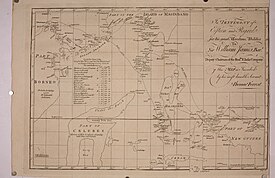Thomas Forrest (navigator)
Thomas Forrest | |
|---|---|
India | |
| Occupation(s) | Navigator and explorer |
Thomas Forrest (c. 1729 – c. 1802) was a British navigator who served in the
Life
He appears to have served for some time in the Royal Navy, and to have been a midshipman in 1745.[1][2]: 106 Passages in his own writings show that he was active in the Malay Archipelago from at least 1753.[3]: 114 The date of his employment by the Marine of the East India Company is not clear, but in 1757 he was master of the Company's sloop Neptune, which left Madras for Bencoolen on 14 August. The ship capsized and sank with the loss of most of its crew. Forrest and two others were rescued. He was next in command of the sloop Fanny trading in arrack and wine in Batavia in 1759, but fell foul of the Dutch who confiscated most of his cargo and damaged the ship. [2]: 107
Forrest then became a "freighter" or private merchant, trading in opium. He was caught up in the
From 1774-1776 he led an exploring mission in the direction of
: 111–112In 1780, Forrest took command of the Company brig Lively, leaving Gravesend on 26 September. He took with him an Arnold chronometer for determinng longitudes in India. He arrived in Madras on 27 March 1781, and was immediately engaged in supporting Britain in the war with France, both transporting people and material and in diplomatic and intelligence activitity. In 1782, in the ketch Fly, he located the French fleet, which had left the coast of India and had eluded Sir Edward Hughes the English commander-in-chief, at Aceh. He was able to bring the information to Vizagapatam, which he reached on 20 December, and this saved a number of ships from capture by the French.[1][2]: 114–115
In the following June, 1783, Forrest set sail from
Forrest is said to have died in
: 121Charts
Forrest constructed the following charts:[4][9]
- Track chart of the Tartar's voyage
- Malaleo and Gag harbours
- W. Part of Batchian and Mandioli Islands with Bissory harbour
- Selang, Piapia, Offak harbours
- Island of Waygiou, Rawak harbour
- Efbe harbour of Mysole island
- Leron harbour
- Bass harbour, Pera river
- Islands between Sulu and Basilan
- S.W. part of Mindanao
- Bunwoot (Bongo) island
- Leno and Ubal harbours
- Kamaladau (Dumanquilas) Bay
- N.E. Coast of Borneo
- N.W. Coast of Borneo
- Siddo harbour near Acheen
- Part of the Mergui islands
- Pera River, Pulo Dingding and the Sambelong Islands
- Keyser's Bay or Semanko on the South Coast of Sumatra
References
- ^ a b c d . Dictionary of National Biography. London: Smith, Elder & Co. 1885–1900.
- ^ JSTOR 41505508.
- ^ a b Forrest, Thomas (1792). A Voyage from Calcutta to the Mergui Archipelago, Lying on the East Side of the Bay of Bengal. Edinburgh: J. Robson, I. Owen, and Balfour.
- ^ a b Dawson, Llewellyn Styles (1885). Memoirs of hydrography, including brief biographies of the principal officers who have served in H.M. Naval Surveying Service between the years 1750 and 1885. Part 1. - 1750 to 1830. Eastbourne: Henry W. Keay. pp. 18–19.
- ^ Forrest, Thomas (1779). A Voyage to New Guinea, and the Moluccas from Balambangan: Including an Account of Magindano, Sooloo and Other Islands; Illustrated with Copper-plates. Performed in the Tartar Galley... During the Years 1774, 1775 and 1776. London and Dublin.
- ^ Marsden, William (1838). Brief Memoir of the Life and Writings of the Late William Marsden. Cox. p. 45.
- ^ Sailing Directions (enroute) India and the Bay of Bengal. 15th Edition (15 ed.). Springfield: National Geospatial Intelligence Agency. 2022. pp. 278–271.
- ^ Forrest; Dalrymple, A. (1783). A Journal of the Esther Brig, Captain Thomas Forrest, from Bengal to Quedah, 1783.
- ^ a b c Catalogue of charts, plans, views, and sailing directions &c (PDF). London: H.M. Stationery Office. 1839. p. 50.
 This article incorporates text from a publication now in the public domain: "Forrest, Thomas (c. 1729-c. 1802)". Dictionary of National Biography. London: Smith, Elder & Co. 1885–1900.
This article incorporates text from a publication now in the public domain: "Forrest, Thomas (c. 1729-c. 1802)". Dictionary of National Biography. London: Smith, Elder & Co. 1885–1900.


![Keyser's Bay or Semanko on the South Coast of Sumatra, Published in 1774 as Admiralty Chart 880[9]](http://upload.wikimedia.org/wikipedia/commons/thumb/7/7d/Admiralty_Chart_No_880_Keyser%27s_Bay_or_Semanko_on_the_South_Coast_of_Sumatra%2C_Published_1774.jpg/196px-Admiralty_Chart_No_880_Keyser%27s_Bay_or_Semanko_on_the_South_Coast_of_Sumatra%2C_Published_1774.jpg)
![Plan of the Pera River, Pulo Dingding and the Sambelong Islands, Published in 1786 as Admiralty Chart No 845[9]](http://upload.wikimedia.org/wikipedia/commons/thumb/8/86/Admiralty_Chart_No_845_Pera_River%2C_Pulo_Dingding_and_the_Sambelong_islands%2C_Published_1786.jpg/253px-Admiralty_Chart_No_845_Pera_River%2C_Pulo_Dingding_and_the_Sambelong_islands%2C_Published_1786.jpg)